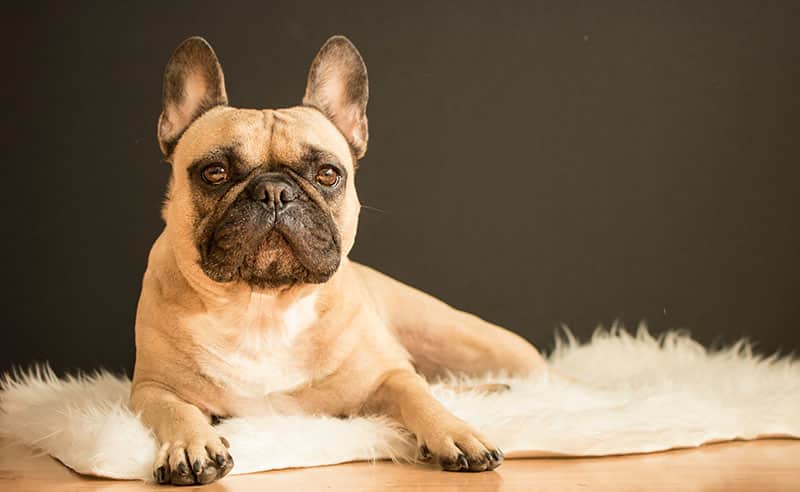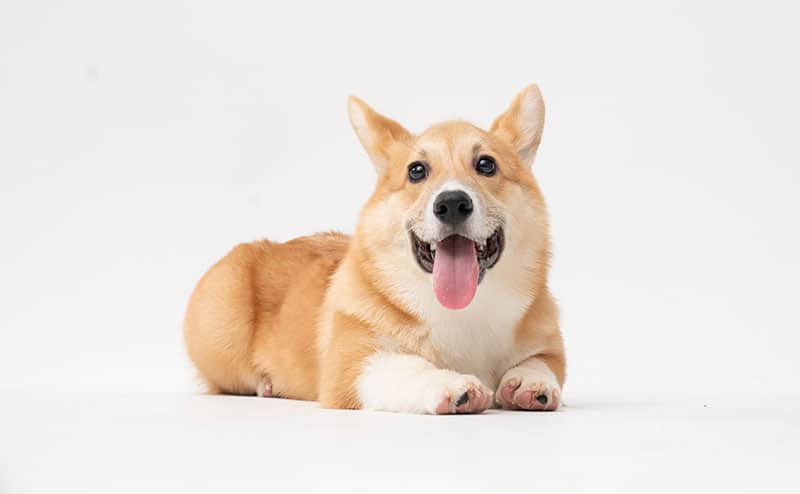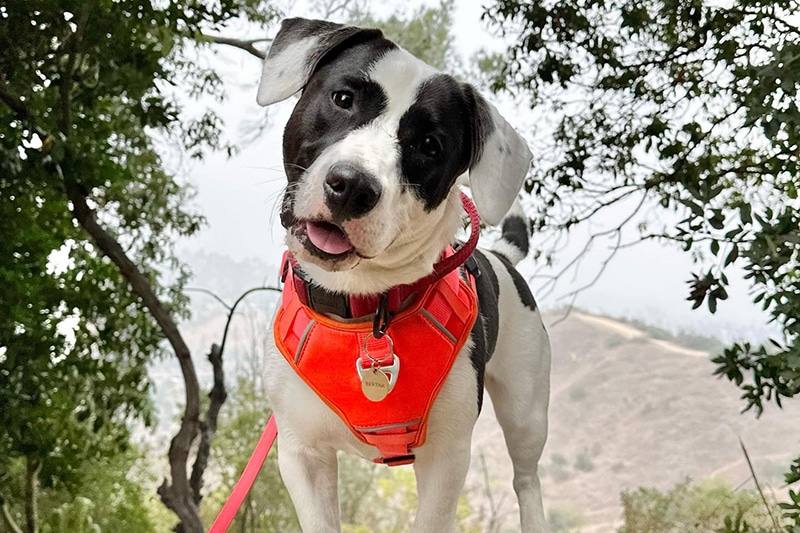The Corgi French Bulldog mix, otherwise known as a Bulldog Corgi, is an adorable, small mixed-breed dog, renowned for being cute and sometimes high-maintenance as it seeks approval and affection from its owners, as part of its French Bulldog genetics.

The Corgi French Bulldog mix is known as a breed that melds the charming nature of the French Bulldog with the active and friendly nature of the Pembroke Welsh Corgi. A wonderful option for families, the elderly, and single people in an apartment living situation – the Bulldog Corgi may make all your small dog dreams come true.
Corgi French Bulldog Mix – At a Glance
| Weight: | 25 – 35 pounds |
| Height: | 12 – 16 inches |
| Lifespan: | 10 – 15 years |
| Coat Colors: | Red, Sable, Fawn, White, Black |
| Temperament: | Attention-seeking, friendly, well-mannered, lively, active |
| Most Suitable For: | Families, single individuals and the elderly |
What Does a Corgi French Bulldog Mix Look Like?

Like most designer breeds, the Bulldog Corgi will borrow its physical characteristics from each parent breed. It will likely be short and stout, like the French Bulldog, but may have the longer body of the Welsh Corgi.
Its head will be wedge-shaped and may have bat-shaped or rounded ears (like the Welsh Corgi). Due to its French Bulldogs genetics, it may also have a flatter face than you’d expect. It’s hard to tell what the color pattern of the Bulldog Corgi will be, as it could come in various coat colors.
Your French Corgi could have a longer tail than traditional Pembroke Welsh Corgis. It’s also likely to have a broad, muscular chest.
Like most hybrid breeds, physical appearances are left to chance and how their genes mix. Their final physical appearance is anyone’s guess and unpredictable.
Are you looking for a way to treat your furry friend? Sign up for our newsletter for a chance to win a free month of Barkbox!
The History of the Corgi French Bulldog Mix
As a designer breed, the Corgi French Bulldog mix hasn’t been around that long, so we don’t have much information about its origins. However, we know it was likely caught up in the crossbreeding craze that hit the United States in the 1990s and early 2000s.
It’s not difficult to see why one would want to crossbreed a Pembroke Welsh Corgi and a French Bulldog. The Pembroke Corgi is notorious for its friendly, happy-go-lucky nature. In comparison, the French Bulldog is renowned for being cute as a button but slightly aloof and wary of strangers. This makes for a cautiously adorable mixed breed.
To better understand how the French Bulldog Corgi came to be, let’s explore the history of the Pembroke Welsh Corgi and French Bulldog in detail.
The History of the French Bulldog

The name “French Bulldog” is a bit of a misnomer – the French Bulldog was created in England in the 19th century. The French Bulldog was created by crossbreeding between English Bulldogs that had been bred to be of smaller sizes – known as Toy Bulldogs – and Parisian ‘ratters,’ or rat terriers – a small Pinscher-type dog used to kill rats in Paris’ streets and homes.
The Bulldogs were brought to France by English families from Nottingham, who had resettled there following the Industrial Revolution – lace workers, mostly.
The French Bulldog was one of the most popular dogs in the United States when it arrived in the latter half of the 19th century. Frenchies were mostly owned by high-society folks, often changing hands for upwards of $3000! The Frenchie maintains that ‘toy’ status today and is considerably less expensive now, but its popularity hasn’t dimmed.
How Popular Are French Bulldogs in the United States?
The French Bulldog arrived in the United States in 1885 and was recognized by the American Kennel Club in 1906. However, it was initially called the “Bouledogue Francais,” but the name was changed in 1912 to “French Bulldog.”
In 2021, the French Bulldog ranked as the 2nd most popular dog in the United States, according to the American Kennel Club.
Who Are French Bulldogs a Good Dog For?
French Bulldogs are known for being friendly, loving, and curious dogs with an independent streak. Their small size and reputation as low-maintenance dogs make them perfect for elderly owners and great family pets.
French Bulldogs also have an independent streak, which means they’ll need a firm owner and one who’s not afraid to be authoritative. Extra training may be necessary, although positive reinforcement as a training method is preferred to harsh admonishment.
How Did French Bulldogs Come About?
French Bulldogs were originally bred in England in the 19th century from English Bulldogs. They were brought to France by English lace workers from Nottingham.
Once there, they were crossbred with French rat terriers – Pinscher-like small dogs to create the modern French Bulldog. They were kept under their French name – “Bouledogue Francais,” until 1912.
When Did We First Cross-Breed The French Bulldog?
The history of crossbreeding of the French Bulldog doesn’t begin in earnest until the late 20th century. Before that, most owners of French Bulldogs liked to keep them as purebred dogs due to them being held in high esteem among high society.
However, during the late 20th and early 21st centuries, French Bulldogs were caught up in a crossbreeding craze that swept the United States. This resulted in many different crossbreeds, including the following:
- French Bulldog Great Dane Mix (Bull Dane)
- French Bulldog Dachshund Mix (Bull Weiner)
- French Bulldog Cane Corso Mix (Bull Corso)
- French Bulldog Pitbull Mix (French Pit)
- French Bulldog Pug Mix (French Pug)
The History of the Corgi

The Welsh Corgi first arrived on British shores in ancient times, accompanying Flemish weavers on their journey from modern-day Belgium to the Pembrokeshire region of Wales. Their Flemish owners first used these small, active dogs as herding dogs, though eventually, they were replaced by larger, stronger dogs.
Welsh Corgis became companion pets over time, splitting the breed into two distinct types – the Pembroke Welsh (the original Corgi breed) and the Cardigan Welsh Corgi. The Cardigan Welsh Corgi was developed in the town of Cardigan, in the Ceredigion region of Wales. For several centuries, Pembroke and Cardigan Welsh Corgis were shown and classified as a particular breed.
The Pembroke Welsh Corgi found favor and fame within the Royal Household of the United Kingdom – Queen Elizabeth II kept over thirty Corgis during her reign – she would often be seen walking her high-energy dogs around the grounds of Buckingham Palace.
The Cardigan Welsh Corgi would fade into relative obscurity in the United Kingdom and the United States – where both breeds would be classified together until 1935, when the American Kennel Club recognized them as separate breeds.
Today, all over the Western world, both the Cardigan Welsh Corgi and Pembroke Welsh Corgi are incredibly popular family pets, especially among elderly owners.
How Popular Are Corgis in the United States?
In the United States, Corgis are incredibly popular – with the Pembroke often falling inside the top ten most popular dogs over the last ten years. This is likely due to their distinctive features, such as an elongated body, double coat, and rounded ears. They also have fantastic personalities, known for being an active breed that’s friendly and pleasant.
They’re also low-maintenance, requiring minimal grooming, making them the ideal choice for an elderly owner.
In 2021, the Pembroke Welsh Corgi was the 11th most popular dog in the United States, while the Cardigan Welsh Corgi was the 67th most popular.
Who Are Corgis a Good Dog For?
Pembroke Welsh and Cardigan Welsh Corgis are active breeds with lively personalities. Pet owners with children should be wary of ‘herding.’ However, this can be trained out of your Corgi.
Corgis are the right size and shape for elderly owners and those living in apartments. They’re also a relatively healthy breed, making them great purebred parents for mixed breeds and low-maintenance dogs to own. They don’t need a lot, but they give you a lot!
They’re incredibly popular family dogs but equally popular among the elderly – fit for a Queen! Corgis, whether Pembroke Welsh or Cardigan Welsh, are wonderful dogs for any owner no matter their living situation, family dynamic, or age.
How Did Corgis Come About?
Welsh Corgis were first brought to the Welsh countryside by Flemish weavers, who relocated to Wales from modern-day Belgium around 1107 A.D. These dogs have a lineage stretching back to the 12th century, making them one of the oldest British dog breeds.
Corgis’ popularity increased over time as they became Royal Household dogs – but their features in shows like “The Crown” piqued audiences’ interest from the UK to the United States, where Corgis were already popular.
When Did We First Cross-Breed The Corgi?
The Corgi has a long and, unfortunately, unwritten history of crossbreeding. Given that this is an ancient breed, it is highly likely that the Corgi was crossbred many times throughout the years without it ever being recorded.
Our records indicate that the Corgi was crossbred with several different dogs before the 1990s when crossbreeding of dogs became incredibly popular in the United States.
How Important Is a Dog’s Temperament to Your Family?
One of the most important parts of owning a dog is ensuring that it is a temperamental match to your family unit. This means taking stock of its parent breeds’ temperament and using that to base your decision to adopt or buy a breed.
When deciding on a breed, you’ll want to get one that matches your family’s habits, activity levels, and temperament. If you are an active, outdoorsy family, it only makes sense to get an active, outdoorsy dog, like a Husky or a Rottweiler. However, if you are homebodies, getting a dog that will be more comfortable around the home makes more sense. Usually, smaller dogs like Shih Tzus, Pugs, and terriers are more comfortable spending their days at home.
Getting a dog that differs from you and your family temperamentally could mean pouring time and money into extensive training for your dog or even being forced to re-home the animal. This means more suffering, trauma, and stress for you, your family, and the dog.
What is the Temperament of the Corgi French Bulldog Mix?
The Bulldog Corgi is renowned for being a friendly, pleasant breed with a mixed temperament. The Bulldog’s side of your French Corgi will likely be shy, reserved, and aloof. Meanwhile, the Corgi’s side of your French Corgi will likely be active, playful, and friendly towards strangers and friends alike.
As designer dogs, the Corgi French Bulldog mix’s temperament borrows from both parents and is a great temperamental choice for the first-time dog owner.
Is The Corgi French Bulldog Mix Friendly?
You can expect your Corgi French Bulldog mix to be amiable, though they may be slightly shy initially.
Is The Corgi French Bulldog Mix Easy to Train?
The Frenchie Corgi will likely be quite easy to train – although you may see the French Bulldog’s stubborn streak – this can be rectified by positive reinforcement training.
How Much Can A Corgi French Bulldog Mix Weigh?
A Bulldog Corgi will typically weigh between 25 and 35 pounds.
How Tall Can A Corgi French Bulldog Mix Get?
The average height of a Corgi French Bulldog mix is between 12 and 16 inches tall.
Similar Sized Breeds
There are a few similar-sized breeds to the French Corgi. These include:
- Cocker Spaniel
- Shetland Sheepdog
- Beagle
- Boston Terrier
Does the Corgi French Bulldog Mix Shed?
Despite having a short coat, you can expect your French Corgi to shed lightly throughout the year. We recommend brushing your Corgi French Bulldog once a week to mitigate shedding.
How Much Exercise Does A Corgi French Bulldog Mix Require?
The French Corgi doesn’t require quite the amount of exercise you might imagine based on its Corgi genes. However, daily exercise is always a good idea – roughly 30 – 45 minutes of exercise will suffice for your furry friend.
Something to bear in mind is: if your French Corgi has inherited the flat face of the French Bulldog, it may suffer from Brachycephalic Obstructive Airway Syndrome. This almost always leads to breathing issues, making intensive exercise unhealthy for your Frenchie Corgi.
How Long Can a Corgi French Bulldog Mix Live?
The average lifespan of a Bulldog Corgi is between 10 and 15 years.
What Health Conditions Could the Corgi French Bulldog Mix Have?
- Brachycephalic Obstructive Airway Syndrome (BOAS) (Leads to breathing difficulties)
- Hereditary Deafness (A common hereditary condition among French Bulldogs)
- Intervertebral Disc Disease (IVDD) (Spinal Cord Disease)
How Can You Find a Corgi French Bulldog Mix Puppy For Sale?
For some people, the Corgi Frenchie mix is an undesirable breed, most likely due to health difficulties that can arise from owning French Bulldogs – namely BOAS – which can lead to very expensive vet bills.
However, if you welcome a Corgi Frenchie mix into your home, it’s best to go the adoption route first rather than purchasing your Corgi mix from a breeder. Adoption is often a fraction of the cost of buying a Corgi Frenchie mix and saves a dog from a lonely existence in a shelter.
Try the animal shelters in your area first or the vet clinics to see if anyone has dropped any Corgi Bulldogs ready for adoption. If that fails, you can look online at AdoptAPet.com for your newest family member!
How Much Does a Corgi French Bulldog Mix Puppy Cost?
The average cost of a Corgi French Bulldog mix is a staggering $1300+! One of the reasons for this is that French Bulldogs are highly sought-after ’boutique’ dogs. This price tag also makes adoption a much more cost-effective way of obtaining a French Bulldog mix puppy.
However, if you do choose to go the way of buying a Bulldog Corgi – maybe you’ve more money than Croesus, who knows? We highly suggest that you read our guide to finding a reputable breeder and avoiding puppy mills!
Is the Corgi French Bulldog Mix the Right Breed For You?
The Corgi French Bulldog is a small, lovable, friendly breed that’s the perfect size for those living in apartments or a family sharing a house with children. They’re gentle and affectionate and don’t mind being left alone (if you’re a busy dog owner). Leave them something to entertain themselves with.
If you’ve been looking for a smaller dog with plenty of personality, the Bulldog Corgi mix might be the right breed. Their daily exercise routine won’t wear you out, and they’re quite happy to be couch potatoes sometimes too.
However, if, after reading our article, you’re not convinced that the Bulldog Corgi mix is the right breed for you and your family, we encourage you to read our other breed guides to find the right match!



